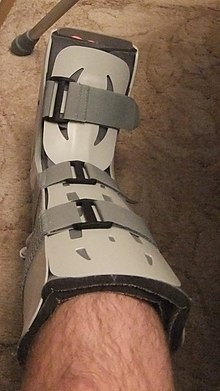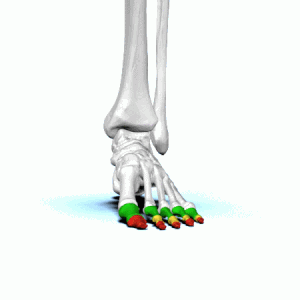Broken toe
| Broken toe | |
|---|---|
| Other names | Bedroom fracture painkillers[3] |
| Prognosis | 4 to 8 weeks for full healing; pain lessens within days[3] |
| Frequency | Common,[3] 8–9% of all fractures[5] |
A broken toe is a type of bone fracture.[5] Symptoms include pain when the toe is touched near the break point, or compressed along its length (as if gently stubbing the toe).[2] There may be bruising, swelling, stiffness, or displacement of the broken bone ends from their normal position.[3]
Toes usually break because they have been stubbed or crushed.
Fractures of the smaller toes are usually treated with rest,
Broken toes are one of the most common types of fracture seen in doctor's offices, and make up just under 10% of fractures in some offices.[2]
Definition and classification
Toe bones or
People vary; sometimes the smallest toe also has none (not shown).[2]
A broken toe is a type of fracture which may be categorised as a big toe fracture or fractures of the lesser toes.
The
Signs and symptoms

Symptoms include pain when the site of the fracture is gently pressed,[7] or when the toe is gently compressed along its length[2] or moved.[6] There may be bruising or swelling;[7] sometimes there is a crackling sound.[7] There may be displacement of the bones; the alignment of the nail bed is compared to the same toe on the uninjured foot to check if the toe has rotated (see spiral fracture).[7]
Injuries to the
Complications
When a toe is broken by crushing, there is often also a subungual hematoma (bleeding/bruising of the nail bed, under the toenail).[3] If there is enough blood to cause pain, it can be drained to relieve the pain and avoid (temporarily) losing the nail.[3] Draining is usually done if the injury is less than 24 hours old. Preserving the nail helps splint the broken toe.[2] Contaminated wounds are more serious; the wound should be kept clean.[9]
Broken toes with open wounds, especially if there is
In high-force crushing and shearing injuries, especially those with open wounds, blood circulation can be impaired.[2]
Causes
Toes usually break because they have been stubbed or crushed.
Risk factors
Kicking the ground during sports may result in "
Mechanism
Because the big toe is more important for weight-bearing, balance, walking, and running, breaks to the big toe are more likely to be problematic.[7][9] If the big toe is stubbed and breaks, it usually breaks the distal (outermost) bone. A crushing injury can break both big-toe bones.[9]
If the joint was bent too far (i.e. either
Diagnosis
Diagnosis is by direct visualisation and sometimes
Differential diagnosis
Differential diagnosis includes sprains of ligaments and tendon injuries.[15]
Treatment
It may not be clear whether the toe is broken or just bruised.[4] In such cases the treatment is usually the same in either case.[4]
Removing rings
Any rings on the toes are removed immediately, before the toe starts to swell.[16][17] Pulling rings off forcefully may worsen the swelling. Relaxation, elevation, icing, lubrication (e.g. soapy water or oil), and rotating the ring as if unscrewing it may help. If these methods don't work, it may be possible to remove the ring by temporarily wrapping the toe with a slick thread (something like dental floss), passing the inner end of the thread under the ring and then unwrapping it, pushing the ring ahead of the unwrapping thread. Failing that, the ring may need to be cut off by a doctor.[18]
Nonoperative


Fractures of the smaller toes are commonly treated by buddy taping (see image). Padding is used between the toes to keep the space dry[3] and the toes aligned comfortably. If the toes are less comfortable when buddy-taped, the buddy tape should be removed.[6]
It is also helpful for shoes to be stiff-soled (to protect the toe from bending),[3] low at the heel[4] (even a <2cm heel can increase pressure on the forefoot by over 20%[19]), and wide.[20][4] Most shoes, especially women's shoes, have a toe box which is more than a centimeter too tight; the width of the foot should be measured standing, with weight on it.[19] Comfortable shoes are recommended; tight, pointy shoes are undesirable.[4] If the top of the shoe is making the broken toe more painful, it is should be changed for something that won't, like open-toe sandals or old sneakers with the toe cut away.[16]
Somewhat more serious fractures which affect a joint, but with less than 2mm displacement and less than 25% of the area of the joint surface on the broken part, are generally also be treated with buddy taping and suitable shoes; the evidence on this treatment is not extensive.[7]
Fractures with displacement at the break, including rotation, can often be reduced (re-aligned) by a family doctor. Some broken toes may need to be put in casts, especially if the fracture is unstable (it won't stay reduced on its own).[2][3] If more than 25% of the area of the joint surface was on the broken-loose part, or the break had to be reduced, follow-up X-rays are done 7–10 days afterwards.[7]
Fractures of the big toe are treated with a short-leg orthopedic walking boot, or a short-leg walking cast with a sole that protrudes beyond the big toe. These are worn for 2–3 weeks. Buddy taping and a rigid sole are then used for 3–4 weeks, if symptoms allow. At four weeks, range-of-motion exercises can start. If the joint was involved or the break had to be reduced, follow-up X-rays are done a week afterwards.[7]
To reduce pain and swelling,
Surgical
Surgery is not needed for most broken toes,
Prognosis
Complete healing may take four to six weeks, and complex cases may take up to eight weeks.[3] Some athletes may need longer.[7] Long-term disability is rare.[2] (see complications section).
Epidemiology
Approximately 8 to 9% of all broken bones are of a toe.[5] Studies have varied as to whether broken big toes are more or less common than broken lesser toes.[1] In a UK study involving nearly 6000 fractures seen in hospital, 3.6% were broken toes.[9] Fractures of big toes make up about a fifth[2] or third[7] of all toe fractures, and 5.5% of all foot and ankle fractures in major US trauma hospitals.[9] Toe fractures are the most common foot fractures.[7] About 20% of broken toes involve open wounds.[9]
Other animals
Buddy strapping can be used for toe fractures in big birds.[21] Sometimes a ball bandage can be used, where the bird curls its toes over it.[21] Due to pneumatic bones in birds, washing an open toe fracture may be harmful.[21] Broken toes in grebes can be splinted but if dislocated, often require amputation.[22] A toe fracture in an elephant may go unnoticed.[23][24] Knocked-up toes in racing greyhounds may be mistaken for a toe fracture.[25]
See also
- Foot fractures
- Subungual hematoma (black nail)
- Interphalangeal joints of the foot (toe joints)
- Phalanges(bones of fingers and toes)
- Broken finger
References
- ^ ISBN 978-1-9751-3606-2.
- ^ PMID 14705761.
- ^ a b c d e f g h i j k l m n o p q r s t u v w x y z "Broken toe - self-care: MedlinePlus Medical Encyclopedia". medlineplus.gov. US National Library of Medicine. 28 March 2020. Retrieved 30 October 2021.
- ^ a b c d e f g "Broken toe". nhs.uk. UK National Health Service. 17 October 2017.
- ^ ISBN 978-0-323-54655-3.
- ^ a b c d "Broken Toe". HealthLink BC. Archived from the original on 7 November 2021. Retrieved 8 November 2021.
- ^ PMID 26926612.
- ISBN 978-0-323-05710-3.
- ^ PMID 33328790.
- ^ S2CID 39138324., page 99 of PDF fulltext
- ISBN 0-8342-0605-6.
- PMID 11858921.
- ^ a b Yochum, Terry R.; Rowe, Lindsay J.; Maola, Chad J. (2005). "9. Trauma". In Yochum, Terry R.; Rowe, Lindsay J. (eds.). Essentials of skeletal radiology (Third ed.). Baltimore: Lippincott Williams & Wilkins. pp. 881–884.
- hdl:10520/EJC48619.
- PMID 14705761.
- ^ a b "Toe Injury". Seattle Children's Hospital. Retrieved 5 December 2021.
- ISBN 978-0-7817-3905-4.
- ^ "Removing a Ring From a Finger or Toe". HealthLink BC. Archived from the original on November 13, 2021. Retrieved November 13, 2021.
- ^ S2CID 29979737. Archived from the original(PDF) on 2019-11-18.
- ^ "Toe and Forefoot Fractures". www.orthoinfo.org. OrthoInfo. American Academy of Orthopaedic Surgeons.
- ^ ISBN 978-0-323-68145-2.
- ISBN 978-1-119-16775-4.
- ISBN 978-0-8138-0676-1.
- PMID 28123909.
- ISSN 0372-5545.




